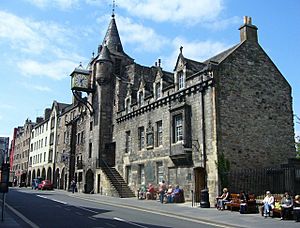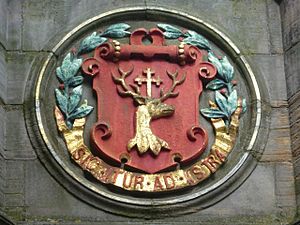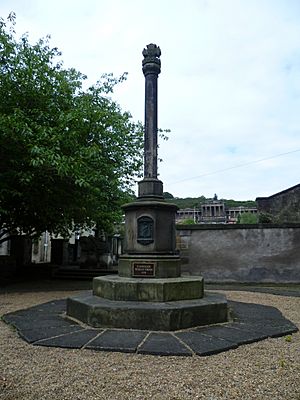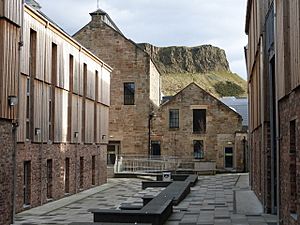The Canongate facts for kids
The Canongate is a famous street and area in the heart of Edinburgh, the capital city of Scotland. It forms the main eastern part of the Royal Mile, which is a historic road leading from Edinburgh Castle to Holyrood Palace. The Canongate area is also the eastern section of Edinburgh's Old Town.
Around 1143, David I of Scotland, a king, allowed Holyrood Abbey to create a new town, or "burgh," separate from Edinburgh. This new town, called Canongate, was managed by the Abbey until the Scottish Reformation (a time of big religious change). After that, it was controlled by regular people, not the church. In 1636, Edinburgh bought the rights to control Canongate, but Canongate still had its own local leaders until it officially became part of Edinburgh in 1856.
The name "Canongate" comes from the path the "canons" (priests) of Holyrood Abbey used to take to Edinburgh. It means "canons' way" or "canons' gait," as "gait" is an old Scots word for "way." Today, the eastern end of the Canongate is sometimes called part of the Holyrood area. Canongate and Edinburgh often had disagreements, mainly about their exact borders, until they joined together in 1856. Many people in Canongate were not happy about this change.
The Canongate has many old and important buildings. These include Queensberry House, which is now part of the Scottish Parliament Building, and Huntly House, which is now the Museum of Edinburgh. You can also find the Canongate Tolbooth, which houses the People's Story Museum, and the Canongate Kirk. The Canongate Kirk opened in 1691 and took over from Holyrood Abbey as the local church. It is still used for church services and concerts today.
Contents
How the Canongate Started
The Canongate exists because Holyrood Abbey was built in 1128. King David I, who started the Abbey, gave the land around it to the Augustinian canons (priests) who lived at Edinburgh Castle. The King also allowed the canons to create a town between the Abbey and Edinburgh. Because it was the only town in the Abbey's area, it was called the "burgh of regality" of Canongate. The land controlled by the Abbey originally included areas like Broughton, the Pleasance, and North Leith, which gave the canons access to a port for ships.
In 1380, the Canongate, which was outside Edinburgh's city walls, was mostly destroyed by fire during an attack by the English army led by Richard II.
Life in Medieval Times
Holyrood Palace grew from the 1300s as kings and queens used the Abbey more and more for important events like meetings of Parliament. The word "Palace" was first used for the royal living areas during the time of King James IV. These buildings were first turned into a proper palace by King James V in 1525.
In 1999 and 2000, archaeologists (people who study old things) found parts of a medieval ditch that marked the old boundary. They think it runs under Holyrood Road. It seems there was one ditch in the 1100s that was filled in, and then a new one was dug in the 1200s or 1300s, with a wooden fence (palisade) added. The archaeologists also found signs of "city walls" built in 1513. These walls were meant to mark boundaries, not to defend the city. Armies attacking Edinburgh usually came through the Water-Yett (Water Gate) and took over the Canongate. Then they would try to attack Edinburgh through the Netherbow Port.
The Rough Wooing Attack
In May 1544, during a conflict called the Rough Wooing, the English army led by Lord Hertford attacked and burned Edinburgh. The English Master of Ordnance, Christopher Morris, brought cannons up the Canongate to attack Edinburgh's Netherbow Gate. Some English gunners were killed during this. The English soldiers attacked the gate and, according to English reports, pulled one of the Scottish cannons through its opening. The Scots couldn't fight back because of heavy gunfire and arrows. Morris then placed a cannon close to the gate. After a few shots, the gate was broken, and the English army rushed in, killing many defenders. The Scottish cannons were moved from the High Street into the Castle. A report sent to Charles V, Holy Roman Emperor said that the English troops were not used to fighting in a city and even fought among themselves on the High Street. One English leader, William Howard, was hurt in the face by an English arrow.
The Marian Civil War

In the 1560s, some of Mary, Queen of Scots's servants had relationships with women in the Canongate. The church leaders (the Kirk Session) didn't approve because these couples often didn't plan to marry. Some of the women were made to stand at the town cross with their heads uncovered for three hours as a punishment.
After Mary was forced to give up her crown, there was a civil war in Scotland. Mary's supporters controlled Edinburgh Castle, while the King's supporters lived in the Canongate and at Leith. In 1571, Regent Lennox (a leader for the young King) stayed in Cuthbert Ferguson's house in the Canongate. The house was protected from cannon fire with bags of wool and animal skins.
Tennis Courts and Places to Stay
There were several tennis courts in Edinburgh and the Canongate. One was near the Palace, at the home of Henry Kinloch. Another was built nearby in 1623 by Alexander Peiris. Kinloch and Peiris also ran lodging houses (places where people could stay). Kinloch hosted the French ambassador Rambouillet in February 1566. Rambouillet was entertained at the Palace by Mary, Queen of Scots with a "maskrie and mumschance" (a kind of masked dance or play) where her ladies dressed in men's clothes. Anne Halkett, a writer, stayed with Peiris at the bottom of the Canongate in 1650. She was told it was a "civil house, and the best quality lay there that had not houses of their own."
Merchants and Craftspeople
Many skilled workers had shops on the Canongate. These included goldsmiths like John Acheson and James Gray, who sold pearls to Mary, Queen of Scots. There were also people who made pistols, like John Kello, and in the 1590s, a clockmaker from Flanders named Abraham Wanweyneburgh. The stonemason Gilbert Cleuch had a house in the Canongate. When King James VI returned to Edinburgh in 1579 after growing up at Stirling Castle, some of his court members, including Jerome Bowie, who managed his wine cellar, bought houses in the Canongate.
Changes in the 1600s and 1700s
When King James VI became King of England in 1603, it started a slow decline for the Canongate. The royal court moved away from Holyrood Palace, which meant less wealth for the area. However, some rich families (aristocrats) continued to live and build large houses and gardens on the street. One example is Mary Sutton, Countess of Home, whose townhouse, Old Moray House, still partly stands today.
The Canongate remained a place where luxury goods and home furnishings were made and sold. For example, striped wool wall hangings for Newbiggin House were woven in the Canongate by James Crommie in 1665. James Leblanc made mirrors, and he had a disagreement with Sarah Dalrymple, who painted furniture and mirrors in the "Japan style," over who could control the supply of glass for mirrors and lights.
The Acts of Union 1707, which joined the Scottish and English parliaments, also affected the area. Before this, Edinburgh was where the Parliament of Scotland met, and the Canongate was a popular place for politicians to live. The North Bridge, which opened in 1772, created a new and easier way to get from Edinburgh to the port of Leith. This route bypassed the Canongate, which had been the main way to Leith via Easter Road. This led to more neglect of the residential area, which gradually became filled with factories, including breweries and a large gasworks. Archaeological digs have shown that many back gardens were turned into industrial sites during this time.
The Canongate was an important area during the Scottish Enlightenment (a time of great thinking and learning). This was partly because of the Canongate Theatre (1746-1786), which was partly owned by Lord Monboddo. The famous philosopher David Hume even acted in a play there.
The Canongate in the 1800s
In 1824, writer Robert Chambers described the Canongate as the "main avenue from the palace into the city." He said that "all that was beautiful, all that was gallant, all that has become historically interesting in Scotland for the last six or seven hundred years" had passed along its pavements.
Sir Walter Scott wrote in 1827: "Sic itur ad Astra; This is the path to heaven." He said this was the old motto of the Canongate, found on its public buildings, from the church to the pillory (a device for public punishment). He also said the Canongate was to Edinburgh what Westminster is to London.
The Canongate Today
The Canongate area has seen many efforts to improve it and clear out old, crowded areas. These included plans by Ebenezer James MacRae in the 1930s and Sir Robert Hurd in the 1950s, which tried to rebuild in a traditional style, copying the old building fronts. Another project, finished in 1969 by the Basil Spence firm, used a modern style but kept the buildings in proportion with the older ones around them.
Because of the rebuilding in the 1950s and 60s, the crowded and poor area lost many residents. From the 1960s onwards, the Canongate became less industrial, with all the breweries closing. New homes, offices, and shops started to be built on old factory sites in the 1990s and 2000s, especially south of the main road. This helped to bring more people back to live there. While many of these new buildings look modern, some effort has been made to keep the "fishbone" pattern of narrow alleys (closes) that is typical of the Royal Mile.
Since 2006, the redevelopment of old industrial land north of the Canongate (where Victorian gasworks and a bus garage once stood) has caused some debate. This was partly because the first plan, which has now been dropped, was to knock down some of the buildings from the 1930s.
Most importantly, the building of the new Scottish Parliament Building on the site of the old Younger's Abbey Brewery has brought new life to the area. The Canongate is now at the heart of Scottish political life.
Education
The Royal Mile Primary School, once called Milton House Public School, is a public school for children aged 5 to 11. It was designed in 1886 by Robert Wilson, who was the architect for the Edinburgh Board of Education.
The school also has a nursery for children aged 3 to 5. Because the school is so important to the Canongate community, its students often take part in special events at the Scottish Parliament and Edinburgh Castle. It is also used as a place where people can vote in elections for the Edinburgh Central area.
The Canongate is also home to Moray House, which is the Education department of the University of Edinburgh. It includes several buildings, some old and some purpose-built, around St. John Street. Other university buildings, like the Pleasance student union and the Centre for Sport and Exercise, are also in the area that was historically part of the Canongate.
Historic Crosses
There were three important crosses along the Canongate part of the Royal Mile.
The old Mercat Cross (Market Cross) or Burgh Cross is shown on a 1647 map as being in the middle of the road, almost opposite the old town hall (tolbooth). The map shows it looked similar to the Edinburgh Mercat Cross, with a tall pole and cross on a stone platform. The cross, which has been changed a lot over time, now stands in the south-east corner of Canongate Churchyard, near the entrance to Canongate Kirk.
The St John's Cross used to stand further west up the Canongate. Its location is now marked by a maltese cross made of different coloured stones in the road surface, near the top of St John's Street. It was called St. John's Cross because it stood on land believed to belong to the Knights of St. John in the Middle Ages. It also marked the old boundary of the part of Edinburgh that was outside the Netherbow Port and the city wall.
The Girth Cross, also known as the "Abbey" or "South" Cross, is now marked by a circle of stones in the road. It marked the western edge of the "Girth of Holyrood," which was the largest sanctuary (a safe place where people could not be arrested) in Scotland. A map from the 1573 siege of Edinburgh shows it as a fancy pole on steps. It was not taken down until after 1767. Important announcements were read and executions were carried out in its shadow. A famous execution happened here in 1600 when Jean Kincaid (Lady Warriston) was beheaded by the Maiden (an old beheading machine) for planning the murder of her abusive husband.
Canongate's Coat of Arms

The coat of arms (a special symbol) of the Canongate shows a white deer's head and a golden cross. This reminds people of an old story where King David I was saved from being attacked by a stag (male deer) when a holy cross suddenly appeared. Even though the Canongate is no longer a separate town since 1856, its coat of arms can still be seen in many places in the area. For example, it's on Edinburgh's mercat cross alongside the royal symbols of Britain, Scotland, England, and Ireland, the symbols of Edinburgh and Leith, and the symbol of the University.
The motto (a short phrase) is Sic itur ad astra, which means 'thus you shall go to the stars'. This quote comes from Virgil's famous poem, Aeneid.
Important Buildings

- Canongate Kirk: Built in 1691.
- Moray House: Built by Mary, Countess of Home around 1625. It was later expanded as Moray House College of Education.
- Queensberry House: Built in 1686, now part of the Scottish Parliament.
- Canongate Tolbooth: Built in 1591, now the People's Story Museum.
- 167–169 Canongate: An early 17th-century building. Its upper floors are part of the People's Story Museum, and the ground floor is a pub.
- Lodge Canongate Kilwinning Number 2: Built in 1736, it is the oldest building made specifically for a masonic lodge that is still used for that purpose. Robert Burns, the famous poet, was invited to be their poet laureate here.
- Chessel's Court: Built in 1745.
- Morocco Land: A building from 1730 with a carved upper body of a Moor (a person from North Africa) on it.
- Shoemaker's Land: A building from 1725.
- Bible Land: A building from 1677.
- Huntly House: From 1517, now the Museum of Edinburgh.
- Whitefoord House: Built in 1769, now home to the Scottish Veterans Association.
- White Horse Close: A beautiful courtyard from around 1680 that was used by coaches traveling between Edinburgh and London. It was restored in the early 1960s.
- Golfers Land
- Palace of Holyroodhouse: The official home of the British monarch in Scotland.
- Holyrood Abbey
Famous People Who Lived Here
- Bruce Chatwin (1940–89): Lived in Canongate while studying at the University of Edinburgh from 1966 to 1968.
- Oliver Cromwell: Stayed at Old Moray House during two visits to Scotland.
- John Craig: A former priest who worked with John Knox in St Giles'.
- John Gay: Stayed at Queensberry House as a guest of his supporter, the 3rd Duke of Queensberry.
- Lord Milton
- Mary Dudley, Countess of Home: Built Old Moray House.
- Very Rev Dr Patrick MacFarlan: Born in the Canongate manse (a minister's house).
- John Notman (1810-1865): An architect and landscape designer.
- Christian Ker Reid: A silversmith born here.
- Tobias Smollett: Briefly stayed at his sister's house above St. John's Pend.
- Adam Smith: Lived in Panmure Close.
- Lord Monboddo: His house stood in St. John's Street.
- Sir William Wardlaw, 16th baronet: Lived at Chessels Court.
- John Nisbet, Lord Dirleton
- William Bannatyne, Lord Bannatyne: Lived and died in Whiteford House.
Canongate in Books
The Canongate appears in chapter 49 of the book Pickwick Papers by Dickens.
Walter Scott named his book Chronicles of the Canongate (from the 1820s) after the area.





